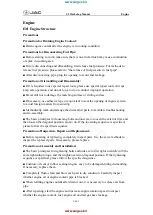
Starting
When you open a door to enter Model S, the instrument
panel and touchscreen power on and you can operate all
controls. To shift Model S, press the brake pedal and
swipe up for Drive or down for Reverse on the
touchscreen's drive mode strip (see
If
Auto Shift out of Park
is enabled, Model S
automatically selects Drive or Reverse based on inputs
from various sensors. Pressing the brake pedal shifts the
vehicle into the selected drive mode displayed on the
instrument panel (provided the driver's door is closed
and the driver's seat belt is buckled), and pressing the
accelerator moves the vehicle in that direction (see
NOTE:
To turn
Auto Shift out of Park
on or off, touch
Controls
>
Pedals & Steering
>
Auto Shift out of Park
.
Before accelerating when
Auto Shift out of Park
is
enabled, check the instrument panel to make sure that
Model S has shifted into the drive mode you want (Drive
or Reverse). If the selection is not correct, or if
Auto
Shift out of Park
is not enabled, swipe up for Drive or
down for Reverse on the touchscreen's drive mode strip
to choose a new drive mode. See
NOTE:
If the
PIN to Drive
feature is enabled (see
), you must also enter a valid PIN on
the touchscreen before you can drive Model S.
Everything you need to know when driving Model S
displays on the instrument panel.
Drive Disabled - Requires Authentication
If Model S does not detect a key when you press the
brake (a key fob or phone key is not detected or two
minutes have passed since you used the key card), the
touchscreen displays a message telling you that driving
requires authentication.
If you see this message, place the key card in either
phone dock where the RFID transmitter can read it. The
two-minute authentication period restarts and you can
start Model S by pressing the brake pedal.
A number of factors can affect whether Model S can
detect a phone key or key fob (for example, the device's
battery is low or dead and is no longer able to
communicate using Bluetooth).
Always keep your phone key, key fob, or a key card with
you. After driving, your key is needed to restart Model S
after it powers off. And when you leave Model S, you
must bring your key with you to lock Model S, either
manually or automatically.
Powering Off
When you finish driving, simply exit the vehicle. When
you leave Model S with your phone key and key fob, it
powers off automatically, turning off the instrument
panel and touchscreen.
Model S also powers off automatically after being in
Park for 30 minutes, even if you are sitting in the driver’s
seat.
Although usually not needed, you can power off Model S
while sitting in the driver’s seat, provided the vehicle is
not moving. Touch
Controls
>
Safety
>
Power Off
.
Model S automatically powers back on again if you press
the brake pedal or touch the touchscreen.
NOTE:
Model S automatically shifts into Park whenever it
determines that you are exiting the vehicle (for example,
the driver's seat belt is unbuckled and the vehicle is
almost at a standstill). If you shift into Neutral, Model S
shifts into Park when you open the door to exit. To keep
Model S in Neutral, see
Instructions for Transporters on
.
Restarting the Touchscreen
You can restart your touchscreen if it is unresponsive or
demonstrates unusual behavior.
NOTE:
To ensure the safety of occupants as well as
other road users, restart the touchscreen only when the
vehicle is in Park.
Starting and Powering Off
51
Driving
Содержание MODEL S 2021
Страница 1: ...MODEL S 2021 OWNER S MANUAL Software version 2022 16 North America ...
Страница 50: ...Steering Yoke 48 MODEL S Owner s Manual ...
Страница 264: ...Publication date 2022 5 1 ...
















































